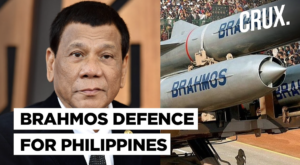The bilateral relationship between India and the Philippines are in a new era, where the defence and strategic ties between both countries are on an upward trajectory in the last few years.
In March 2021, India signed a framework agreement with the Philippines that provided for government-to-government deals for the supply of defence material and equipment. India and the Philippines are formally set to seal a government-to-government BrahMos deal soon. The procurement is expected to signal a major upswing in India’s strategic ties with the Philippines which has been focusing on ramping up its naval prowess in the face of its lingering friction with China in the South China Sea.[i]
According to the Philippines Department of Budget Management (DBM), two separate ‘special allotment release orders’ (SARO) worth 1.3 billion pesos (Rs 224 crore) were issued. The missile flies at a speed of 2.8 Mach or almost three times the speed of sound. The variant to be exported is likely to have a range of around 290 kilometres. It is learnt that initially, the Philippines will procure the missiles for its navy though the country is also looking at the weapons for its land forces as well.[ii]
Impact on China
India has historically taken a neutral position in the disputes along the South China Sea involving China and countries of Southeast Asia, even as the tensions have threatened the security in the region.
As we know that China territory expansionism idea seen to be the return of Chinese expansionist policies. Under the Qing rule, China expanded beyond the Great Wall and started to annex more territories in process. The Qing invaded Korea, managed to conquer Mongolia, and also annexed modern territories of Xinjiang and Tibet as well.[iii]
And now, China has eyes on the Indian Territory especially the Indian Ocean. Indian Ocean is most important for China strategically as it helps, through the link the Indian Ocean to the Pacific Ocean. Due to which China is not backing down from claiming controversial territory in the South China Sea as its own and creating tension between China and several other nations — including Taiwan, Malaysia, the Philippines and Vietnam.
The Indian Ocean and the Pacific Ocean have many nodules that are rich in manganese; nickel, copper, and cobalt are particularly widespread in the deep basins of the Pacific and Indian Oceans. Crusts that mainly contain iron and manganese can also have significant concentrations of cobalt, rare earth elements, nickel, tellurium, and platinum; they are found on seamounts (extinct submarine volcanoes that are found throughout the ocean) and other seafloor promontories. Muds that contain rare earth elements—widely used in consumer electronics such as smart phones and green technologies such as wind turbines and hybrid and electric cars—are found in the deep ocean. These muds are a relatively new discovery.[iv]
It is believed that India’s BrahMos Supersonic Missile System will be the game change for Taiwan, Indonesia, Malaysia, the Philippines and countries of south Asia. A major benefit of the BrahMos Supersonic Missile is that it creates psychology tension which influences and pressurizes China to bow down on land.
*Rahul Panwar is a graduate student of political science with specialization in defence studies at Shri Guru Ram Rai University.
[i] Philippines set to conclude BrahMos missile deal. The Times of India, December 30, 2021 https://timesofindia.indiatimes.com/india/india-philippines-set-to-conclude-brahmos-missile-deal/articleshow/88595747.cms
[ii] Philippines to buy India’s BrahMos missiles. Times Aerospace, January 14,2022 https://www.timesaerospace.aero/news/defence/philippines-to-buy-indias-brahmos-missiles#:~:text=The%20acquisition%20of%20the%20BrahMos,government-to-government%20deal.&text=The%20Philippines’%20department%20of%20budget,requirements%20for%20the%20missile%20system
[iii] Please see Ten Great Campaigns, Wikipedia https://en.wikipedia.org/wiki/Ten_Great_Campaigns
[iv] Pacha Aswathi. 2019. Explained |What is India’s Deep Ocean Mission. The Hindu, August 04, 2019 https://www.thehindu.com/sci-tech/science/why-is-india-pulled-to-deep-sea-mining/article28809029.ece


